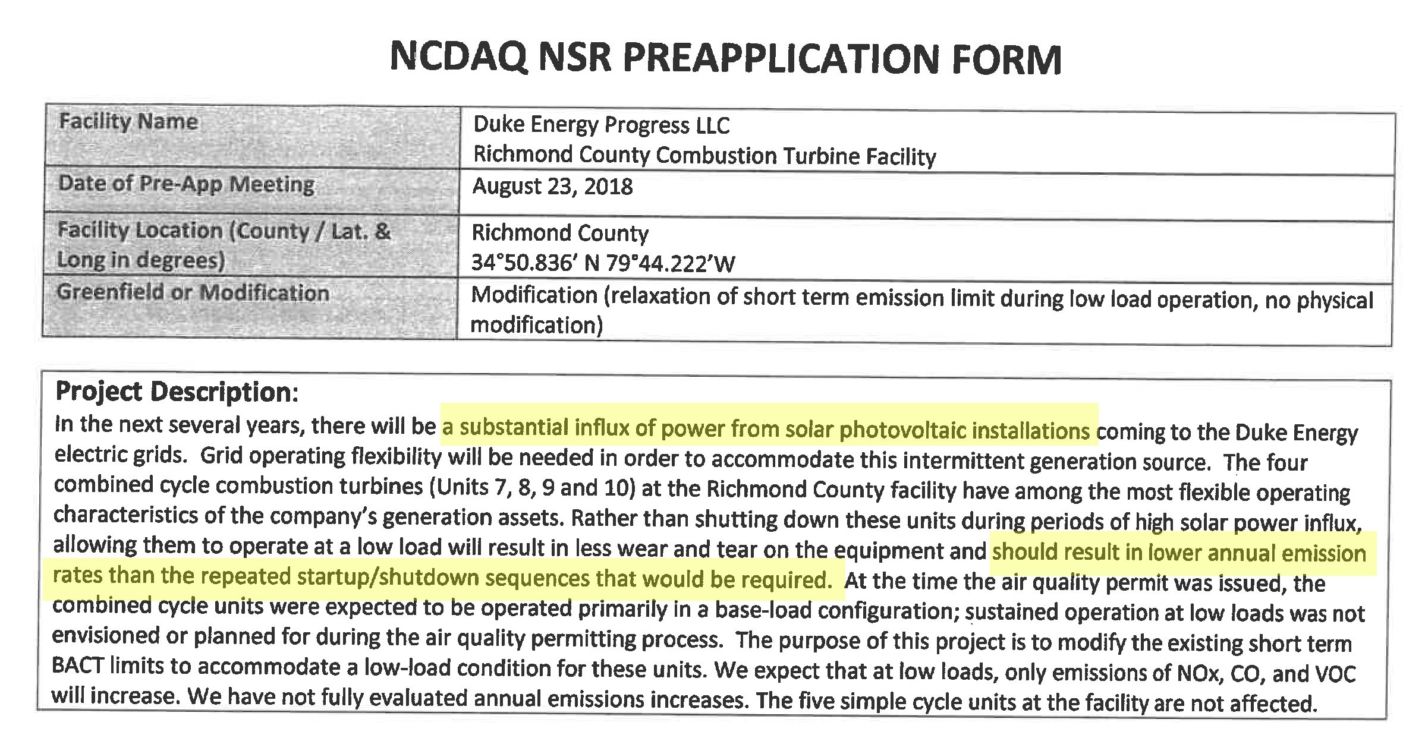- In determining the reliability of different electricity generation sources, a source’s “capacity factor” is a useful measure of how much it produces vs. how much it says it can produce
- A source is “dispatchable” if it can produce or adjust its output to meet changes in electricity demand, but it is “nondispatchable” and “intermittent” if it must rely on the whims of nature to be able to generate
- Other measures include “output factor” for dispatchable sources and “effective load carrying capacity” for intermittent renewable resources, and in comparing those measures, what stand out are the rock-solid reliance of nuclear and the gaping seasonal variance of already intermittent solar
Long-time state utilities law in North Carolina recognizes public interest in “least cost” and “reliable” service and declares upholding those values state policy. A recent state law seeking to bring about “carbon neutral” electricity provision by 2050 made sure to install those least cost and reliable guardrails on the process. This research brief examines ways of assessing the reliability of different electricity generation sources.
Capacity factor
A standard approach to gauging reliability is capacity factor, which is the proportion of power actually produced over a period of time from a generating unit of electricity (such as a natural gas combined-cycle turbine or a solar facility) compared with how much power it could produce at its full, advertised capacity in continuous operation during that period. Capacity factor differs from nameplate capacity, which is the most electricity production that can be expected from a generating unit at any point in time.
Capacity factor loosely gives an idea of how close a generating source comes to producing at its best. The closer, the more reliable. Traditional power plants that have ready access to fuel for generation — uranium, natural gas, coal, or water — have much higher capacity factors than intermittent renewable power facilities that rely on the whims of nature (sunshine and wind) to be able to generate.
For example, Gov. Roy Cooper received a stark lesson on the difference between nameplate capacity and actual production when Strata Solar applied to build a solar facility on Cooper’s Nash County land. The facility would have a 5-megawatt (MW) nameplate capacity — but the application noted that “Solar is an intermittent energy source, and therefore the maximum dependable capacity is 0 MW.”
The U.S. Energy Information Administration (EIA) lists the annual capacity factors of different energy sources nationally as follows (2022 data):
Annual capacity factors of different generating source, nationally (2022)
- Nuclear: 92.7%
- Natural gas: 56.6%
- Coal: 48.4%
- Hydroelectric: 36.3%
- Wind: 35.9%
- Solar: 24.4%
Those figures are useful for general comparison and expectation. What if one is interested specifically in how North Carolina’s energy sources compare? Using the EIA’s data for North Carolina, here are the capacity factors for the state’s energy sources:
Annual capacity factors of different generating source, North Carolina (2022)
- Nuclear: 95.6%
- Natural gas: 73.2%
- Hydroelectric: 33.1%
- Coal: 32.8%
- Wind: 27.7%
- Solar: 21.5%
Coal’s capacity factor in North Carolina differs significantly from the national numbers (32.8% vs. 48.4%). The issue seems to be less of whether coal can produce when needed and more a matter of how often is coal needed to produce. Aided by price-competitive natural gas from the revolution in hydraulic fracturing and horizontal drilling, the state’s electric utilities have moved dramatically over the past decade and a half away from coal-fired generation. In 2000, coal generated nearly two-thirds (62.1%) of the state’s electricity, by 2014 it was closer to one-third (38.4%), and by 2021 coal was responsible for only 15.7% of electricity generation in North Carolina.
Dispatchable or not
For a fuller picture of reliability, then, capacity factor is not enough. Another measure is dispatchability: whether a generating source can produce or can adjust its output (i.e., can be dispatched) to meet changes in electricity demand. Electricity must be consumed when it is produced. Slower dispatchable sources (nuclear and coal) tend to be the baseload, workhorse, always-on sources (see, e.g., nuclear production before, during, and after the Christmas Eve 2022 blackouts). The fastest dispatchable sources work well for peaking production (sources that can be quickly ramped up to meet a demand peak), including hydroelectric facilities and natural gas combustion turbines.
Another use for a fast dispatchable source like natural gas is to provide backup generation to cover nondispatchable, intermittent solar and wind’s uncertainties, fickleness, and total inability to produce more when demand increases. As a report prepared for Duke Energy on solar’s reliability contribution phrased it, “Because solar and wind are intermittent resources, a solar or wind facility’s ability to provide reliable capacity when it is needed is different from that of a fully dispatchable resource such as a gas-fired turbine, which can be called upon in any hour to produce energy, notwithstanding unit outages.”
Ironically, because ostensibly zero-emissions solar and wind require this backup generation, they result in increased emissions. Furthermore, because the way they tend to use those backup resources is less efficient — repeatedly shutting them down and restarting them again, rather than keeping them always on — their emissions tend to be greater.
For example, Duke Energy Progress sought permission from the Division of Air Quality for combustion turbine (natural gas) units that will back up solar facilities to be allowed to throttle up and down from “low load” idling rather than from being shut down during periods of high solar activity. Doing so, the Duke request stated, “should result in lower annual emission rates than the repeated startup/shutdown sequences” would cause.
Note that both uses of combustion turbines in backup of an intermittent renewable source — startup/shutdown and idling — result in more emissions than they would in normal operation. As Dan Way reported for the North State Journal,
Without any solar power in the mix, “a typical combined cycle combustion turbine emits NOx at approximately 9-11 lb/hr, assuming 24 hours of ‘normal’ operation,” [Duke spokeswoman Kim] Crawford said. That is equivalent to 264 pounds of NOx [nitrogen oxide] emissions daily. When those same plants are operated to supplement solar power facilities, daily emissions more than double to 624 pounds a day, based on a table in Duke’s application.
If DEQ agrees to Duke’s alternative operating scenario, a combustion turbine would emit 381 pounds of NOx daily — still 44% more pollution than operating without any solar power on the grid.
Here are those numbers in comparison:
Nitrogen oxide (NOx) emissions from a typical combined cycle combustion turbine, according to Duke Energy
- 264 lbs./day without solar
- 381 lbs./day with solar, if allowed low load (idling) operation when it’s sunny
- 624 lbs./day with solar, if made to shut down when it’s sunny and have to start back up later

Image from Duke Energy Progress preapplication packet form to the North Carolina Division of Air Quality (Source: Dan Way, North State Journal)
ELCC and output factor
Capacity factor gives an idea of a generating source’s reliability in terms of its production compared with its advertised (nameplate) capacity, tempered by need for it. Dispatchability gives an idea of a source’s reliability in terms of its availability to be used when people need it, without accounting for when it might otherwise be available. There are two other comparable ways of considering generating sources’ reliability.
For intermittent renewable sources, the measure is effective load carrying capacity (ELCC). What ELCC attempts to measure is how much additional load on a balanced electrical system is met by adding the renewable resources to the system. For example, if 40 additional megawatts (MWs) of new load is balanced by the addition of 100 MWs of a renewable resource, the ELCC of that resource is 40%.
For dispatchable resources, a commensurate measure is output factor. Like capacity factor, it is a measure of net generation in comparison with the amount of generation expected based on the generating source’s expected capacity. A key difference is that it takes into account when the source is called upon to generate. So if a dispatchable source such as hydroelectric or coal is not used as much as it could be, it would see a lessening of its capacity factor, but not its output factor.
Following are how North Carolina generation sources compare under those measures, using averages derived from Duke Energy reports concerning dispatchable resources and solar and wind ELCC studies conducted for Duke by Astrapé Consulting:
Annual productivity factors (output factor or ELCC) of different generating sources, North Carolina (2022-23)
- Nuclear: 100.3%
- Hydroelectric: 86.4%
- Natural gas: 80.4%
- Coal: 51.2%
- Wind: 38.8%
- Solar: 3.5% winter average; 45.4% summer average
Two items stand out especially in those comparisons: the rock-solid reliance of nuclear and the gaping seasonal variance of already intermittent solar. Nuclear’s output factor being over 100% reflects that nuclear units in North Carolina actually outproduced their expected output.
One problem with ELCC is that it can be used as a rationale for overbuilding inefficient and unreliable renewable energy facilities, which are already expensive (especially offshore wind facilities, which are too expensive for sober consideration).
Fortunately for North Carolinians, having those least cost and reliable guardrails in law should prevent the North Carolina Utilities Commission from being cozened into allowing — or worse, requiring — state electricity consumers to be saddled with the costs and service problems of a grid overloaded with a redundancy of expensive, unreliable, intermittent facilities.


